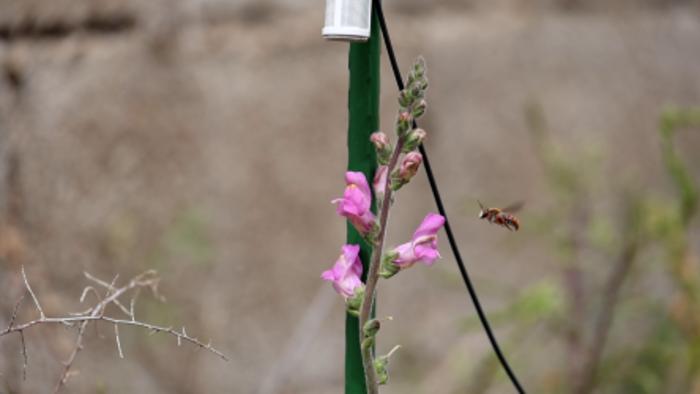In the intricate dance of nature’s coevolution, plants and their pollinators have traditionally communicated through a symphony of visual cues and olfactory signals. Yet, an emerging realm of scientific inquiry reveals a more subtle, often overlooked language: vibrational acoustics. Recent research spearheaded by Professor Francesca Barbero of the University of Turin, alongside a multidisciplinary team of entomologists, sound engineers, and plant physiologists hailing from Spain and Australia, uncovers the profound influence of pollinator-generated vibrations on plant physiology and gene expression, hinting at a sophisticated acoustic dialogue that shapes ecological interactions.
This pioneering study targets the vibrational sounds produced by pollinators, particularly the Rhodanthidium sticticum bee, a species specialized in pollinating snapdragon plants (Antirrhinum litigiousum). Unlike the more conspicuous auditory signals of insect life, such as buzzing wings or movement noise, these vibrations are remarkably subtle, often drowned out by the ambient acoustics of natural habitats. Consequently, scientific attention to this nuanced channel has been scant, leaving a critical gap in understanding pollinator-plant interactions beyond visual and chemical modalities.
Professor Barbero’s team utilized advanced audio recording technology to capture the delicate vibratory signals emitted by these bees during their approach and interaction with snapdragon flowers. By replaying these sounds in controlled environments adjacent to growing snapdragons, the researchers meticulously monitored the floral responses using biochemical assays and transcriptomic analyses. The results revealed that exposure to authentic bee buzzes triggered a substantial increase in nectar production, with concomitant elevation in sugar concentration, thereby enhancing the floral reward available to the pollinators.
On a molecular level, the analysis showed significant upregulation of genes involved in sugar transport and nectar biosynthesis pathways. This gene expression modulation suggests that snapdragon plants are not passive entities merely awaiting pollinators but are instead active participants capable of perceiving and transducing vibroacoustic cues into physiological changes. Such dynamic responsiveness indicates a potential evolutionary advantage, whereby plants can maximize reproductive success by fine-tuning nectar offerings to attract and retain efficient pollinators.
The implications of these findings extend beyond nectar modulation. By altering their internal gene expression in response to the characteristic sound signatures of beneficial pollinators, plants may effectively influence pollinator behavior, fostering increased visitation time and floral fidelity. This mechanism might serve as a subtle yet powerful tool in ensuring efficient pollen transfer, improving cross-pollination rates, and ultimately enhancing plant fitness within diverse ecosystems.
Moreover, the study illuminates the possibility that plants may possess discriminatory ability, distinguishing between the vibroacoustic signals of efficient pollinators and those of nectar thieves or less effective visitors. The differential response to such signals could represent an adaptive strategy to optimize resource allocation, conserving energy for interactions that confer the greatest reproductive payoff. While the snapdragon-Rhodanthidium system offers compelling evidence for such specificity, ongoing research aims to extend these findings across varying pollinator species and plant families.
Beyond the plant’s response to pollinator sounds, the question remains whether reciprocal acoustic communication exists—can plants emit specific vibrations that attract or guide pollinators? Though not yet conclusively demonstrated, this line of inquiry probes into an untapped modality of ecological interaction, suggesting that plants might actively manipulate their acoustic environment to influence insect behavior. Should future studies validate this phenomenon, it could revolutionize the understanding of plant signaling and open avenues for innovative agricultural practices.
Indeed, the integration of vibroacoustic ecology with traditional sensory biology compels a reexamination of how plants perceive and respond to their biotic surroundings. The multi-modal nature of plant signaling—combining visual, chemical, and vibrational cues—reflects a complex sensory landscape shaped by millions of years of coevolution. Recognizing the significance of vibration perception enhances the conceptual framework surrounding plant intelligence and environmental responsiveness, positioning acoustics as a fundamental aspect of plant biology.
Further technological advancements in recording equipment and analytical software have been instrumental in enabling this research. High-resolution vibrational sensors, sensitive audio capture devices, and sophisticated data modeling permit the isolation and precise characterization of minute acoustic signals previously undetectable. By leveraging these tools, researchers can decipher the subtleties of interspecies communication embedded within natural soundscapes.
The ongoing collaborative project, entitled "Good Vibes: How do plants recognise and respond to pollinator vibroacoustic signals?", funded by the Human Frontier Science Program, embodies an interdisciplinary approach to address these complex ecological questions. Partner institutions—the University of Turin, I²SysBio in Valencia, and the Centre for Audio, Acoustics and Vibration at the University of Technology Sydney—collectively bring expertise spanning biology, acoustics, and environmental sciences, highlighting the necessity of cross-sector collaboration to unravel nature’s acoustic dialogues.
As the research progresses, attention is turning toward practical applications within agriculture and conservation. Harnessing sound-based interactions to boost crop pollination could offer a sustainable strategy to mitigate pollinator declines and enhance yields. If plants’ acoustic responses are manipulable, then artificial vibratory stimulation might augment nectar production or attract native pollinators to targeted crops, reducing dependency on chemical inputs and fostering ecological balance.
In sum, the discovery that plants respond dynamically to the vibroacoustic signatures of pollinators challenges existing paradigms and unveils a hidden layer of ecological interaction. It propels scientific understanding beyond the traditionally explored sensory mechanisms and ushers in a new era where acoustics is recognized as a vital conduit of life’s interconnected web. The ramifications for ecology, agriculture, and even evolutionary biology are profound, underscoring the notion that the “language of flowers” extends beyond scent and sight into the vibrations carried on the air.
Subject of Research: Plant-pollinator vibrational acoustic communication and its impact on plant physiology and gene expression.
Article Title: Vibrational Dialogues: How Pollinator Buzzing Shapes Snapdragon Nectar and Gene Expression
News Publication Date: May 21, 2025
Web References:
- https://acousticalsociety.org/asa-press-room/
- https://acousticalsociety.org/
- https://www.icacommission.org/
Image Credits: Vibrant Lab
Keywords: Acoustics, Bioacoustics, Plant-pollinator interactions, Vibroacoustic signals, Nectar production, Gene expression, Snapdragon, Rhodanthidium sticticum, Pollination ecology




